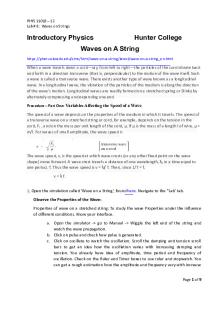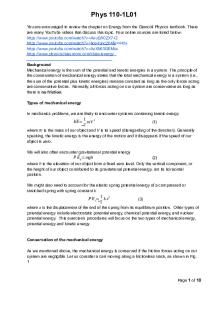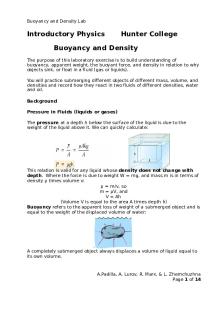Newton\'s Second Law phys 181 lab report PDF

| Title | Newton\'s Second Law phys 181 lab report |
|---|---|
| Author | Sarah Bedor |
| Course | Introductory Laboratory I |
| Institution | University of Arizona |
| Pages | 8 |
| File Size | 239.9 KB |
| File Type | |
| Total Downloads | 105 |
| Total Views | 157 |
Summary
full lab report #2 for first physics lab...
Description
Acceleration Experiment for Confirming Newton’s Second Law
Sarah Bedor
Lab partner: Anna Ebenal Course: PHYS181-009 TA: Islam Shalaby Due Date: 11:00 AM on 09/25/2019
Abstract The purpose of this lab was to test and confirm Newton’s Second Law by measuring the accelerations of a cart as a function of the applied force and as a function of mass. The acceleration of a moving cart was measured along a frictionless track as a function of its mass and applied force. The acceleration was analyzed using a smart cart containing an accelerometer built into it. It was discovered that the greater the applied force to the cart, the greater the acceleration was. As well, the greater the mass of the cart, the less the acceleration was.
Introduction In the lab, the acceleration of a moving cart was measured along a frictionless surface with varying amounts of mass on the cart and applied force on the cart. The first part of the lab measured the acceleration for a varying applied force on the cart. The total mass for the system was fixed, but masses from on top of the cart were moved onto the hanging mass attached to the cart via a string by increments of 20 grams for each trial. The acceleration was measured for varying applied forces as represented by weights on the hanging mass for 20 grams, 40 grams, 60 grams, 80 grams, and 100 grams (keeping the total system mass fixed at 600 grams). For each weight, three runs were measured and the acceleration for each run was recorded. The second part of the lab measured the acceleration for a fixed force on the cart, but with varying masses on the cart. The mass on the hanger was fixed at 100 grams for a fixed force on the cart, but the cart mass varied with masses of 500 grams, 750 grams, 1000 grams, 1250 grams, and 1500 grams. Each of the five trials for the given cart masses had three runs each and the acceleration was measured for each run. The acceleration was measured using the PASCO software and the smart car, which recorded a linear slope of cart velocity as a function of time. This slope value was the acceleration for each run since the change in velocity over change in time equals the acceleration.
Normal Force
Tension Tension (or mass*gravity of hanging mass)
Mass*gravity
Mass*gravity Cart
Hanging Mass
Figure 1: Free body diagrams for the cart and the hanging mass. The hanging mass experiences a tension force and a weight force, which are equal in magnitude. The cart experiences a weight force and a normal force that cancel out since they are equal in magnitude and opposite in direction, but it also experiences the tension force from the string (equal to the weight force of the hanging mass).
Procedure In the first part of the lab, the acceleration of the moving cart was measured on a frictionless surface as the applied force increased (represented as the mass on the hanger) and the weight on the cart decreased. A smart cart was used that was linked to the sparklink interface. Mass was added to the 250-gram cart to make it have a mass of 580 grams. The cart was also attached to a hanging weight via a string that ran through a pulley as depicted in Figure 2. The hanger weighed 5 grams and enough mass was added to make it have a mass of 20 grams. The cart was released from rest and the acceleration was measured. This measurement was repeated three times. Separate trials were conducted for different weights, where 20 grams was taken off of the cart mass and added to the hanging mass (the applied force).
cart
Hanging mass
Figure 2: Schematic for lab set up where m1 represented the cart and m2 represented the hanging mass attached to the cart through a string. The cart was placed on top of a frictionless track and the string connecting the hanging mass and the cart was run over a pulley. In the second part of the lab, the acceleration of the cart was measured on a frictionless surface where the hanging mass remained constant at 100 grams, but the mass of the cart increased in increments of 250 grams. The smart cart was linked to the sparklink interface and PASCO software was sued to measure the acceleration. The cart mass started at 500 grams and the acceleration was measured for three runs using this mass. Then, trials were run for cart masses of 750 grams, 1000 grams, 1250 grams, and 1500 grams where each cart mass had three runs measuring the acceleration of the cart.
Theory In this lab, the acceleration of a moving cart on a frictionless surface was measured as a function of the applied force and as a function of mass. The cart’s acceleration was directly proportional to the applied force on the cart and inversely proportional to the mass. The force can be found using the equation of Newton’s second law ´ a´ ∑ F=m where the only applied force on the cart is the tension force from the hanging mass. This equation can be rewritten as
(1)
a =
F m
(2)
where it was discovered that the acceleration and force vectors must point in the same direction. Also, the total mass of the system must be used when considering Newton’s second law and can be found using the equation M total=M cart +m hanging
(3)
Next, the gravitational force on the hanging mass needed to be found using the equation
|F|=m hanging g
(4)
where the equation for acceleration and the previous two equations make the new equation a =
m hanging g Force = Mass M cart +m hanging
(5)
Equation 5 gave us the theoretical acceleration of the smart cart.
Results and Sample Calculation The acceleration of a smart cart on a frictionless surface was measured as a function of the applied force and as a function of mass. The above equations were used to calculate expected accelerations of the cart. For part one of the lab, the expected acceleration can be calculated for the first trial using equation 5 a =
m hanging g Force = Mass M cart +m hanging
a =
Force ( 20 )( 9.8 ) = Mass (580) +( 20 )
a =.327
m s2
for the theoretical acceleration of the cart. The expected acceleration measurement was found based upon the mass of the cart and the hanging mass, or the applied force on the cart. This equation can be used to find the theoretical accelerations for each trial with the varying masses. The measurements of the actual acceleration values are recorded in tables 1 and 2 at the end of the lab report.
Conclusion and Discussion From this lab, it was discovered that the greater the applied force on the cart ( m hanging g ), the greater the acceleration of the cart was. In the first part of the lab, as the hanging mass would increase in increments of 20 grams, the acceleration would also increase. This finding was also displayed in Table 1 and Graph 1. The slope for Graph 1 was 14.95, showing a positive relationship between the hanging mass (applied force) and the acceleration of the cart. This finding agrees with the acceleration equation that was derived (equation 2) that represented the acceleration as being directly proportional to the applied force. Also, the acceleration of the cart was inversely proportional to the cart mass, as evidenced by Table 2 and Graph 2. The slope for Graph 2 was 0.93, showing a positive relationship between the inverse total mass and the acceleration of the cart. This finding agrees with the acceleration equation that was derived (equation 2) that represented the acceleration as being inversely proportional to the total mass. There could have been multiple sources of error in our experiment that would cause slight variations in our measurements. One of the sources of error could be in the way that the cart was released from rest. Since my lab partner and I switched off between who would release the cart and who would record the acceleration, the cart could have been released differently between the two of us, causing minor inaccuracies in the accelerations measured. Also, another source of error could have been from the graphical recording of the velocity as a function of time graphed electronically on PASCO software. The source of error within this was from when we would highlight a linear portion of the graph to find the slope. The error came from choosing which portion of the graph to highlight in order to find the slope (the acceleration) for that trial, since choosing more or less of the linear portion of each graph may produce different slopes
Tables, Drawings, and Graphs Total Mass:
0.600 kg
Hanging Mass (kg)
Cart Mass (kg)
0.020
.580
0.421
0.040
0.560
0.060
Acceleration (m/s2)
Acceleration (m/s2)
Acceleration (m/s2)
Average Acceleration (m/s2)
0.428
0.433
0.427
0.662
0.680
0.627
0.656
0.540
0.955
0.977
0.981
0.971
0.080
0.520
1.30
1.29
1.30
1.30
0.100
0.500
1.61
1.60
1.60
1.60
Table 1: Total mass of system was kept constant but the mass values changed each trial for both the hanger and the cart for experiment 1
Hanging Mass:
0.100 kg
Cart Mass (kg)
Total Mass (kg)
0.500
0.600
1.61
1.59
1.61
1.60
0.750
0.850
1.13
1.16
1.14
1.14
1.00
1.10
0.910
0.892
0.912
0.905
1.25
1.35
0.730
0.749
0.756
0.745
1.50
1.60
0.638
0.642
0.653
0.644
Acceleration (m/s2)
Acceleration (m/s2)
Acceleration (m/s2)
Average Acceleration (m/s2)
Table 2: The mass of the hanger was kept constant and the mass of the cart was varied for experiment 2
Graph 1: Average Acceleration as a Function of Hanging Mass from part one of lab. There is a positive linear relationship in the graph, meaning that the acceleration increases as the hanging mass does.
Graph 2: Average Acceleration as a function of inverse total mass for the second part of the lab. There is a positive linear relationship for the graph, indicating that the acceleration is inversely proportional to the total mass of the system....
Similar Free PDFs

Newtons second law
- 3 Pages

LAB Report Newton\'s Second Law
- 6 Pages

Phys lab report 2
- 14 Pages

PHYS Lab Report 3
- 7 Pages

Phys lab 4 - Lab report
- 10 Pages

Phys lab 8 - Lab report
- 9 Pages

Phys lab 5 - Lab report
- 10 Pages

Phys lab 10 - Lab report
- 14 Pages

Phys 208 Lab Report # 3
- 3 Pages

LAB Report #4 phys 224
- 5 Pages

PHYS 215 Vectors - Lab Report
- 2 Pages
Popular Institutions
- Tinajero National High School - Annex
- Politeknik Caltex Riau
- Yokohama City University
- SGT University
- University of Al-Qadisiyah
- Divine Word College of Vigan
- Techniek College Rotterdam
- Universidade de Santiago
- Universiti Teknologi MARA Cawangan Johor Kampus Pasir Gudang
- Poltekkes Kemenkes Yogyakarta
- Baguio City National High School
- Colegio san marcos
- preparatoria uno
- Centro de Bachillerato Tecnológico Industrial y de Servicios No. 107
- Dalian Maritime University
- Quang Trung Secondary School
- Colegio Tecnológico en Informática
- Corporación Regional de Educación Superior
- Grupo CEDVA
- Dar Al Uloom University
- Centro de Estudios Preuniversitarios de la Universidad Nacional de Ingeniería
- 上智大学
- Aakash International School, Nuna Majara
- San Felipe Neri Catholic School
- Kang Chiao International School - New Taipei City
- Misamis Occidental National High School
- Institución Educativa Escuela Normal Juan Ladrilleros
- Kolehiyo ng Pantukan
- Batanes State College
- Instituto Continental
- Sekolah Menengah Kejuruan Kesehatan Kaltara (Tarakan)
- Colegio de La Inmaculada Concepcion - Cebu




